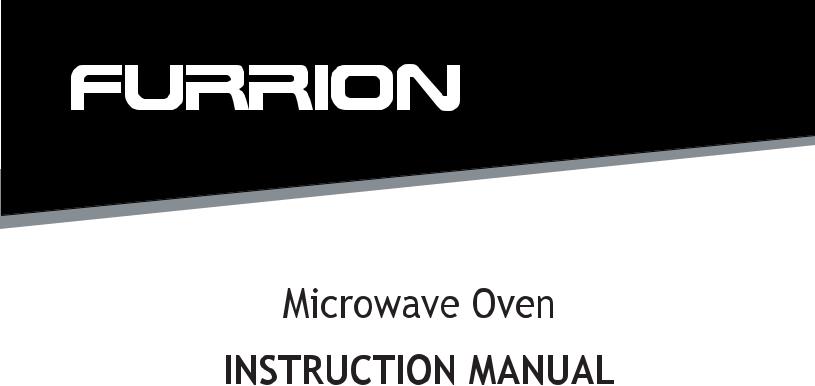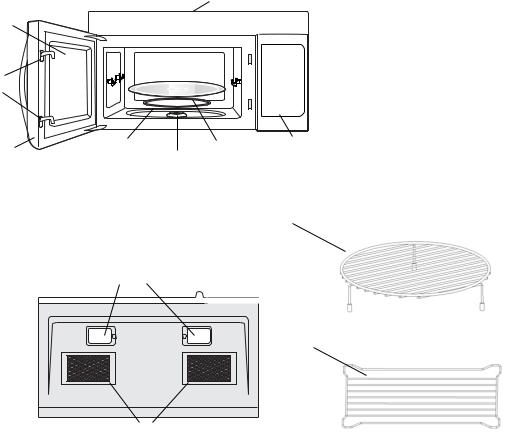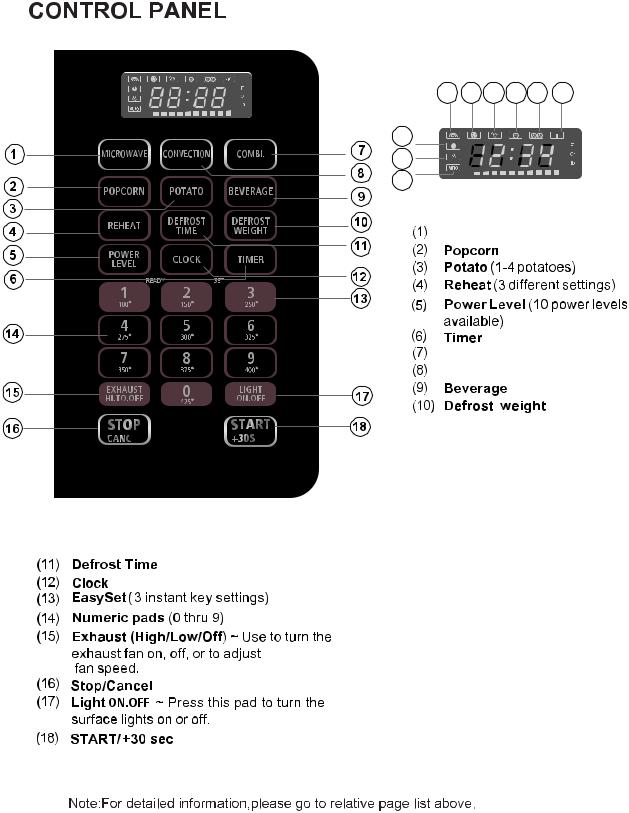Furrion FMCM15-BL, FMCM15-SS User Manual

Model:FMCM15-BL
FMCM15-SS
Read these instructions carefully before using your
microwave oven, and keep it carefully.
If you follow the instructions, your oven will provide you with
many years of good service.
SAVE THESE INSTRUCTIONS CAREFULLY

PRECAUTIONS TO AVOID POSSIBLE EXPOSURE TO EXCESSIVE MICROWAVE ENERGY
(a)Do not attempt to operate this oven with the door open since this can result in harmful exposure to microwave energy. It is important not to defeat or tamper with the safety interlocks.
(b)Do not place any object between the oven front face and the door or allow soil or cleaner residue to accumulate on sealing surfaces.
(c)Do not operate the oven if it is damaged. It is particularly important that the oven door closes properly and that there is no damage to the:
(1)DOOR (bent)
(2)HINGES AND LATCHES (broken or loosened)
(3)DOOR SEALS AND SEALING SURFACE
(d)The oven should not be adjusted or repaired by anyone except properly qualified service personnel.
Specifications
Model: |
FMCM15-BL |
|
FMCM15-SS |
|
|||
|
|
|
|
Rated Voltage: |
120V~ 60Hz |
|
120V~ 60Hz |
|
|
|
|
Rated Input Power(Microwave): |
1500 W |
|
1500 W |
Rated Output Power(Microwave): |
900 W |
|
900 W |
|
|
|
|
Rated Output Power(Convection): |
1450 W |
|
1450 W |
Oven Capacity: |
1.5 Cu.ft.(42 L) |
|
1.5 Cu.ft.(42 L) |
|
|
|
|
Turntable Diameter: |
13.6 inch(345 mm) |
|
13.6 inch(345 mm) |
External Dimensions: |
29.9X15.7X15.0 inch |
|
29.9X15.7X15.0 inch |
Net Weight: |
Approx. 66.4 Lbs(30.1kg) |
|
Approx. 69.4 Lbs(31.5kg) |
2
IMPORTANT SAFETY INSTRUCTIONS
WARNING
To reduce the risk of burns, electric shock, fire,injury to persons or exposure to excessive microwave oven energy when using your appliance, follow basic safety precautions, including the following:
1.Read all instructions before using the appliance.
2.Read and follow the specific: "PRECAU-
TIONS TO AVOID POSSIBLE EXPOSURE TO EXCESSIVE MICROWAVE ENERGY" found on page 2.
3.As with most cooking appliances, close supervision is necessary to reduce the risk
of a fire in the oven cavity.
4.To reduce the risk of fire in the oven cavity:
i). Do not overcook food. Carefully attend the appliance when paper, plastic, or other combustible materials are placed inside the oven to facilitate cooking. ii).Remove wire twist-ties and metal handles from paper or plastic containers/bags before placing them in the oven.
iii). If materials inside the oven ignite, keep the oven door closed. Turn the oven off, and unplug the appliance. Disconnect the power cord, shut off power at the fuse or circuit breaker panel. iv). Do not use the oven cavity for storage purposes. Do not leave paper products, cooking utensils, or food in the cavity when not in use.
5. This oven must be grounded. Connect only to properly grounded outlet. See
"GROUNDING INSTRUCTIONS" found on page 4.
6. Install or locate this oven only in accordance with the installation instructions provided.
7. Some products such as whole eggs and sealed containers-for example, closed glass jars-are able to explode and should not be heated in the oven.
8.Use this appliance only for its intended uses as described in this manual. Do not use corrosive chemicals or vapors in this appliance. This oven is specifically designed to heat or cook or dry food. It is not designed for
industrial or laboratory use.
9.As with any appliance, close supervision is necessary when used by children.
10.Do not operate this oven if it has a damaged cord or plug, if it is not working properly or if it has been damaged or dropped.
11.This appliance should be serviced only by qualified service technicians. Contact the nearest authorized service facility for examination, repair or adjustment.
12.Do not cover or block any openings on the oven.
13.Do not store or use this appliance outdoors.
14.Do not use this oven near water, for example, near a kitchen sink, in a wet basement, near a swimming pool, or similar locations.
15.Do not immerse cord or plug in water.
16.Keep cord away from heated surfaces.
17.Do not let cord hang over edge of table or counter.
18.When cleaning surfaces of door and oven that comes together on closing the door, use only mild, nonabrasive soaps or detergents applied with a sponge or soft cloth.
3

19.Liquids, such as water, coffee, or tea are able to be overheated beyond the boiling point without appearing to be boiling. Visible bubbling or boiling when the container is
removed from the microwave oven is not always present. THIS COULD RESULT IN VERY HOT LIQUIDS SUDDENLY BOILING OVER WHEN THE CONTAINER IS DISTURBED OR A SPOON OR OTHER UTENSIL IS INSERTED INTO THE LIQUID.
i)Do not overheat the liquid.
ii)Stir the liquid both before and halfway through heating it.
iii)Do not use straight-sided containers with narrow necks.
iv)After heating, allow the container to stand in the microwave oven for a short time before removing the container.
v)Use extreme care when inserting a spoon or other utensil into the container.
20.Do not Operate any heating or cooking appliance beneath the appliance. 21.Do not mount unit over or near any portion of heating or cooking appliance. 22.Do not mount over sink.
23.Do not store anything directly on top of the appliance surface when the appliance is in operation.
SAVE THESE INSTRUCTIONS
GROUNDING INSTRUCTIONS
DANGER
Electric Shock Hazard Touching some of the internal components can cause serious personal injury or death. Do not disassemble this appliance.
WARNING
Electric Shock Hazard Improper use of the grounding can result in electric shock. Do not plug into an outlet until appliance is properly installed and grounded.
Three-pronged (grounding) plug
This appliance must be grounded. In the event of an electrical short circuit, grounding reduces the risk of electric shock by providing an escape wire for the electric current. This appliance is equipped with a cord having grounding wire with a grounding plug. The plug must be plugged into an outlet that is properly installed and grounded.
Consult a qualified electrician or serviceman if the grounding instructions are not completely understood or if doubt exists as to whether the appliance is properly grounded. If it is necessary to use an extension cord, use only a 3-wire extension cord that has a 3-pronged grounding plug, and a 3-slot receptacle that will accept the plug on the appliance. The marked rating of the extension cord shall be equal to or greater than the electrical rating of the appliance.
4
1.A short power-supply cord is provided to reduce the risks resulting from becoming entangled in or tripping over a longer cord.
2.Longer cord sets or extension cords are available and may be used if cared is exercised in their use.
3.If a long cord sets or extension cord is used:
1)The marked electrical rating of the cord set or extension marked electrical rating of the cord set or extension cord should be at least as great as the electrical rating of the appliance.
2)The extension cord must be a grounding-type 3-wire cord; and
3)The longer cord should be arranged so that it will not drape over the countertop or tabletop where it can be pulled on by children or tripped over unintentionally.
Radio Interference
1.Operation of the microwave oven may cause interference to your radio, TV or similar equipment.
2.When there is interference, it may be reduced or eliminated by taking the following measures:
1)Clean door and sealing surface of the oven
2)Reorient the receiving antenna of radio or television.
3)Relocate the microwave oven with respect to the receiver.
4)Move the microwave oven away from the receiver.
5)Plug the microwave oven into a different outlet so that microwave oven and receiver are on different branch circuits.
UTENSILS
CAUTION
Personal Injury Hazard
Tightly-closed utensils could explode. Closed
containers should be opened and plastic pouches should be pierced before cooking.
See the instructions on "Materials you can use in
microwave oven or to be avoided in microwave oven."
There may be certain non-metallic utensils that are not
safe to use for microwaving. If in doubt, you can test the
utensil in question following the procedure below.
Utensil Test:
1.Fill a microwave-safe container with 1 cup of cold water (250ml) along with the utensil in question.
2.Cook on maximum power for 1 minute.
3.Carefully feel the utensil. If the empty utensil is warm, do not use it for microwave cooking.
4.Do not exceed 1 minute cooking time.
5
Materials you can use in microwave oven
Utensils |
Remarks |
|
|
Aluminum foil |
Shielding only. Small smooth pieces can be used to cover thin parts of |
||
|
meat or poultry to prevent overcooking. Arcing can occur if foil is too |
||
|
close to oven walls. The foil should be at least 1 inch (2.5cm) away from |
||
|
oven walls. |
|
|
Browning dish |
Follow manufacturer’s instructions. The bottom of browning dish must be |
||
|
at least 3/16 inch (5mm) above the turntable. Incorrect usage may cause |
||
|
the turntable to break. |
|
|
Dinnerware |
Microwave-safe only. Follow manufacturer's instructions. Do not use |
||
|
cracked or chipped dishes. |
|
|
Glass jars |
Always remove lid. Use only to heat food until just warm. Most glass jars |
||
|
are not heat resistant and may break. |
|
|
Glassware |
Heat-resistant oven glassware only. Make sure there is no metallic trim. |
||
|
Do not use cracked or chipped dishes. |
|
|
Oven cooking |
Follow manufacturer’s instructions. Do not close with metal tie. Make |
||
bags |
slits to allow steam to escape. |
|
|
Paper plates |
Use for short–term cooking/warming only. Do not leave oven unattended |
||
and cups |
while cooking. |
|
|
Paper towels |
Use to cover food for reheating and absorbing fat. Use with supervision |
||
|
for a short-term cooking only. |
||
Parchment |
Use as a cover to prevent splattering or a wrap for steaming. |
|
|
paper |
|
|
|
Plastic |
Microwave-safe only. Follow the manufacturer’s instructions. Should be |
||
|
labeled "Microwave Safe". Some plastic containers soften, as the food |
||
|
inside gets hot. "Boiling bags" and tightly closed plastic bags should be |
||
|
slit, pierced or vented as directed by package. |
|
|
Plastic wrap |
Microwave-safe only. Use to cover food during cooking to retain |
||
|
moisture. Do not allow plastic wrap to touch food. |
|
|
Thermometers |
Microwave-safe only (meat and candy thermometers). |
|
|
Wax paper |
Use as a cover to prevent splattering and retain moisture. |
|
|
Materials to be avoided in microwave oven
Utensils |
Remarks |
|
Aluminum tray |
May cause arcing. Transfer food into microwave-safe dish. |
|
Food carton with |
May cause arcing. Transfer food into microwave-safe dish. |
|
metal handle |
|
|
Metal or metal- |
Metal shields the food from microwave energy. Metal trim may |
|
trimmed utensils |
cause arcing. |
|
Metal twist ties |
May cause arcing and could cause a fire in the oven. |
|
Paper bags |
May cause a fire in the oven. |
|
Plastic foam |
Plastic foam may melt or contaminate the liquid inside when exposed |
|
|
to high temperature. |
|
Wood |
Wood will dry out when used in the microwave oven and may split |
|
|
or crack. |
|
6

PART NAMES
Microwave features
|
|
Front View |
1 |
Window |
|
|
|
|
|||
|
|
|
2 Interlock system |
||
|
|
8 |
3 Door assembly |
||
|
|
|
4 |
Turntable ring assembly |
|
1 |
|
|
5 |
Turntable Shaft |
|
|
|
|
|||
|
|
|
6 Turntable glass tray |
||
|
|
|
7 Control panel |
||
2 |
|
|
8 |
Ventilation openings (on top) |
|
|
|
9 Surface lights |
|||
|
|
|
|||
|
|
|
10 Ventilation filters |
||
|
|
|
11 Wire rack (use in convection and combination |
||
3 |
4 |
6 |
7 |
cooking on the removable turntable ) |
|
12 |
Shelf (use in microwave cooking) |
||||
|
|
5 |
|||
11
Bottom View
9
Front
12
Rear
10
7

19 |
20 21 22 23 |
24 |
25
26
27
Microwave
Combination
Convection
(19)Microwave indicator
(20)Convection indicator
(21)Lock indicator
(22)Vent Fan Of Low-Speed indicator
(23)Vent Fan O f High-Speed indicator
(24)stove Lamp indicator
(25)Timer indicator
(26)Defrost indicator
(27)Auto Cook indicator
8

BEFORE OPERATING
Learn more about your microwave oven
•To avoid risk of personal injury or property damage, do not operate the microwave oven empty.
•To avoid risk of personal injury or property damage, do not use stoneware, aluminum foil, metal utensils, or metal trimmed utensils in the microwave oven.

 NOTES
NOTES
Do not to use paper products when using Bake brown or combination bake brown with microwave.
Microwave utensil guide
|
Use |
|
Do not use |
|
• |
Oven proof glass (specifically treated |
• |
Metal utensils: |
|
|
for high intensity heat): |
|
Metal shields the food from microwave energy and produces uneven |
|
|
Utility dishes, loaf dishes, pie plates, |
|
||
|
|
cooking. Also, avoid metal skewers, thermometers or foil trays. Metal |
||
|
cake plates, liquid measuring cups, |
|
||
|
|
utensils can cause arcing, which can damage your microwave oven. |
||
|
casseroles and bowls without metallic |
|
||
|
• |
Metal decoration: |
||
|
trim. |
|||
|
|
Bowls, cups, serving plates and platters without metallic trim. |
||
|
|
|
||
• |
China: |
• |
Aluminum foil: |
|
|
Bowls, cups, serving plates and platters |
|||
|
|
Avoid large sheets of aluminum foil because they hinder cooking and |
||
|
without metallic trim. |
|
||
|
|
may cause harmful arcing. Use small pieces of foil to shield poultry |
||
|
|
|
||
• |
Plastic: |
|
legs and wings. Keep ALL aluminum foil at least 1 inch from the side |
|
|
walls of the oven cavity and door of the microwave. |
|||
|
Plastic wrap (as a cover) - lay the plastic |
|
||
|
• |
Wood: |
||
|
wrap loosely over the dish and press it to |
|||
|
the sides. Vent plastic wrap by turning |
|
Wooden bowls and boards will dry out and may split or crack when |
|
|
back one edge slightly to allow excess |
|
you use them in the microwave oven. Baskets made of wood will react |
|
|
steam to escape. The dish should be |
|
in the same way. |
|
|
deep enough so that the plastic wrap will |
• |
Tightly covered utensils: |
|
|
not touch the food. Use plastic dishes, |
|||
|
|
Be sure to leave openings for steam to escape from covered |
||
|
cups, semi-rigid freezer containers and |
|
||
|
plastic bags for short cooking times. Use |
|
cookware. Pierce plastic pouches of vegetables or other food items |
|
|
these with care because the plastic may |
|
before cooking. Tightly closed pouches may explode. |
|
|
soften from the heat of the food. |
• |
Brown paper: |
|
• |
Paper: |
|
Avoid using brown paper bags. They absorb heat and can burn. |
|
• Flawed or chipped cooking utensils: |
||||
|
Paper towls, waxed paper, paper napkins |
|||
|
|
Any utensil that is cracked, flawed or chipped may break in the oven. |
||
|
and paper plates with no metallic trim or |
|
||
|
design. Look for the manufacturer’s label |
• |
Metal twist ties: |
|
|
for any special instructions for use in the |
|||
|
|
Remove metal twist ties from plastic or paper bags. They become hot |
||
|
microwave oven. |
|
||
|
|
and could cause a fire. |
||
|
|
|
||
|
|
|
|
|
9
